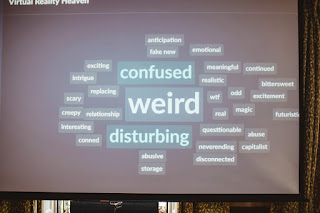Step 10: The Play's The Thing
In spite of consistently reminding everyone involved that this secondment is more about the process than the production, it is very hard to work with a theatre company & not think about the performances as the true measure of our success.
We have all learned an awful lot along the way: about creative collaborations; about science communication; about work-shopping ideas with young people & the great Bristol public; about listening & not assuming expertise or ignorance; about recognising inconsistency & surprise as valuable assets. Even in the latter phases of the process, before we get to the performances themselves, we have benefited across the board from preparation: the writing process has helped us discuss ideas internally (in a way that we hope to discuss them with the audiences); designing the marketing campaign has made us think about who we want involved in the conversation & how we can reach them & persuade them to join us.
Whatever anyone might tell you to the contrary: “the play is not the thing”. Really, in a research-arts collaboration, the process is the thing. Nevertheless, eventually the moment comes where the metaphorical curtain rises & we invite all-comers to take a seat at the table & join our ‘knowledge transfer’.
Except... we don’t have a curtain & we’d rather the audience didn’t actually sit down. Over the years we have evolved a Kilter style, which enrolls the audience as spect-actors at a theatrical event. In our experience, there are few things more deadening for an enquiring mind than being sat in a comfy chair with the lights off. That’s a traditional theatre format & it’s very reassuring & restful but we want our audiences to feel a part of the story that we’re telling so that they have a stake in the outcomes & an opinion to express about the decisions taken to create it.
Generally, Kilter performances share a non-theatre space with audiences in a real environment of lights & sound that the characters & the audience-members cohabit. For instance our Virtual Reality performance, VR100, took place in a pub function room. Not with rows of chairs facing a stage but a few tables to stand around with birthday party nibbles & a free first drink. The moment the audience members entered our room, they were on-stage. They were no longer passive observers but guests at Grandpa’s 100th birthday party. The actors are already live, improvising interactions with the guests to set the scene & establish the world…
“Kathleen! It is Kathleen isn’t it? How nice to see you. Thank you for coming. Grandpa will be thrilled that you’re here. Our Amazon local-drone delivery has been delayed but do tuck into the retro food - very 2030!”
It’s fairly exhausting for the performers, coming up with 30 odd variants of a formula like this whilst remaining convincingly naturalistic but for the audience there is an immediate investment. They are on the front foot putting two & two together. They have something to talk about whilst the rest of the guests arrive & the room settles down. They are willing to engage in the world we are setting in a visceral way that can only be achieved by the immediacy of sparkling eye-contact or a warm shaking of hands and the taste of a room-temperature cream-cake!
Time & again that's the feedback we get from our audiences. To quote one pre-eminent newspaper review ‘Kilter places it’s audiences at point-blank range’ without ‘preaching but in a tender non-threatening’ way. If it goes well - & it tends to because the audience wants it to as much as we do - then the show finishes with warm applause & a hunger to immediately proceed to the next course: a full-on heated discussion about the surprises, the twists & character arcs, the themes, the details & the big question: what happens next?


Comments
Post a Comment